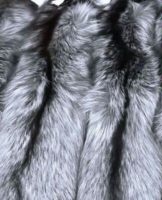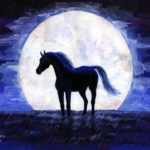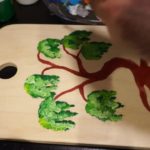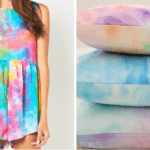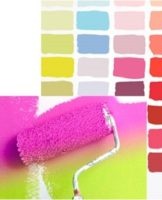What can be painted with gouache, top-7 techniques and a master class for beginners
Gouache is a favorite paint of professional artists and children. The contents of the jars and tubes are diluted with water, and then it's a matter of technology, you can paint a country landscape or a poster for Labor Day. There are many drawing techniques - from simple brushstrokes to dabbing the canvas with a sponge, and sprinkling paint and drawing with fingers will appeal to both children and adults. Drawing is a form of sophrology. Mental balance will quickly be restored when creating gouache drawings.
Content
- 1 General tips for budding artists
- 2 Basic information about gouache
- 3 Varieties of gouache and their characteristics
- 4 How to choose a brush for painting pictures
- 5 What can you lean on
- 6 What drawing techniques exist
- 7 Unconventional painting techniques
- 8 Gouache painting techniques
- 9 Simple step-by-step paintings
- 10 Interesting ideas for beginners
- 11 Master class on complex drawing
- 12 Secrets and intricacies of working with gouache
General tips for budding artists
Gouache was painted by famous foreign and domestic masters - Pablo Picasso, Salvador Dali, Albrecht Durer, Alexander Benois, Boris Kustodiev. Water-based paints are worth taking seriously, although they are more commonly used to color crafts. They are easier to work with than oil paints.
Gouache painting includes portraits, landscapes, still lifes, abstractions, paintings in the style of surrealism. Before picking up a brush, you should familiarize yourself with the basic principles of working with gouache:
- start drawing with a pencil sketch, then apply paints;
- learn drawing techniques in landscapes;
- go from simple to complex, from schematic images to detailed images;
- make distant objects darker and closer ones brighter;
- describe the center of the composition;
- start drawing from the top of the sheet;
- first apply paint to large objects, then draw small details;
- draw outlines in a contrasting color;
- apply shadow using purple, blue, green, but do not paint it black;
- correct errors on a completely dried paint;
- as it dries, the tones lighten, therefore, when applying, you need to pick up the thicker paint;
- to draw clouds, we use white, the grass is light green and the trees are dark green;
- before applying a new drawing technique, first practice on a draft.
To draw, you will need:
- paper, canvas;
- paints;
- brushes;
- simple pencil;
- gum;
- palette;
- palette knife;
- glass for water.
The pallet can be replaced with a wooden board of any size. Having mastered the work of color and the construction of a composition, the artists do without pencil drawing on canvas.The sketches are made in an album in order to reproduce the landscape seen in color from sketches.

A palette knife is a metal tool similar to a construction trowel for applying cement. With its help, gouache is cleaned and applied to the canvas.
Basic information about gouache
Gouache is a water-based paint. It is created on the basis of watercolors, but it has a thicker consistency and a more saturated color, does not spread on the canvas. In the manufacture of gouache, whitewash, natural pigments and mineral additives are used : fruit gum, honey, glycerin, oils, but also acrylic. To thicken the mass, add starch, dextrin, gum arabic. Thanks to the titanium paint in the composition of the tone, the gouaches are more muted.
The components of paints for different types of work are different. School poster paint contains PVA glue.
Characteristics of gouache paint:
- can be applied in layers, on the background after drying, draw small details and create volumetric patterns;
- paint dried in a can dissolves with water;
- no chemical solvent is needed to correct an error in a drawing.
Using gouache paint is easy - just add water. It dries quickly, is gentle on the skin and washes off easily. Gouache is used for artistic painting on the nails, used in body art. It is used for airbrushes and covers large areas.
Varieties of gouache and their characteristics
The properties of gouache differ depending on the purpose. Professional paints are diluted with water beforehand, and a wet brush is simply dipped in children's paints.
Artistic
Paint for creating intricate works of art has a uniform consistency. The tones fall flat and the image looks three-dimensional.The surface of the painting on the canvas is velvety matte. A single stroke is enough to cover the watercolor. Persistence and decorative properties are provided by gum arabic - the resin of the Arabian acacia. Artistic gouache packaging is labeled with the word "luxury" or "premium". The colors are as close to natural as possible to create realistic paintings.

Attach
Painting for writing on canvas, Whatman paper, cardboard, painting plywood decorations. Poster gouache contains kaolin - white clay, thanks to which the color does not fade over time. There is no additional marking on the packaging, only the word "gouache". These paints are suitable for children's creativity and learning to draw. The palette is less diverse and consists of basic colors. For posters, gouache is children's gouache, easy to recognize by the glossy cartoon packaging.
Fluorescent
Decorative type of gouache with organic substances - phosphors. Special pigments make images brighter in sunlight and neon colors are visible in the dark. For fixing, PVA glue and an antiseptic are added to the composition. Fluorescent gouache is less dense, so it is applied only on a white surface. Fluorescent gouache belongs to special effect paints. A variety of mother-of-pearl is also used to decorate the designs. It's more transparent than usual. Bright and shiny types of gouache do not mix well with artistic gouaches.
Acrylic
The most durable gouache adheres to any surface thanks to the acrylates contained in the composition. Decals and designs will not fade over time and stay vibrant. Acrylic gouache is used for painting glass and wooden products.
How to choose a brush for painting pictures
When working with various techniques, the shape of the brush is important:
- flat - used for applying one-color paint to large areas of the canvas;
- round, oval - suitable for all types of work, the line thickness increases with pressure;
- contour, thin - allows you to delicately make small details, strokes;
- fan - used to fill the background.
Brushes are chosen according to the painting technique. They are made from natural hair and synthetic yarn.
Types of brushes used for teaching drawing:
- squirrel - medium soft with a pointed end for fine strokes. Suitable for drawing small details. Squirrel bristle brushes wear out quickly;
- core - the pile of the Siberian furry animal is more durable and hard;
- goat - wide and narrow brushes are suitable for drawing large objects;
- synthetic - nylon velor lasts a long time, is used for painting the bottom;
- pig - hard brushes make the surface of the canvas or paper textured;
- badgers - suitable for applying diluted gouache.
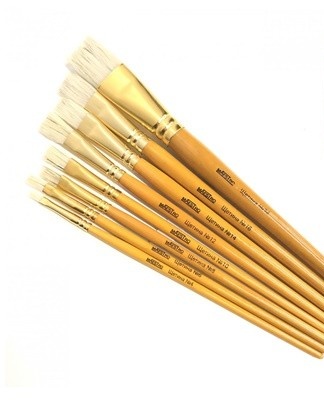
Visual special effects are created using brushes and silicone threads. To create a voluminous and realistic still life, in addition to brushes, foam sponges, paper towels and rollers are used.
What can you lean on
They paint with thick and dense gouache on paper, fabric, transparent and opaque hard surfaces. The main requirement for the base on which thick paint is applied is density.
Paper
The ideal surface for studying the art of painting is smooth white Whatman paper, cardboard, high density A4 paper. Tinted and watercolor paper is suitable for gouache painting.
Corrugated cardboard deforms over time.
Plywood
In second place in terms of usability after cardboard is a wooden base.
The finished work must be varnished.
Glass
Gouache is used to paint dishes and windows.
To preserve the paint, the parts are varnished. Gouache paint snowflakes on the windows for the New Year.
Textile
Batik, or fabric painting, transforms objects into works of art.
To fix the paint, the canvas is covered with a special varnish for fabrics.
What drawing techniques exist
Gouache is a versatile paint that is suitable for both traditional and non-traditional techniques. The main techniques are pasty and icing. With experience, artists combine them and add their own inventions.
icing
The technique consists of applying the paint alternately in layers. First, apply the first coat, wait for it to dry, then apply the next one.If you continue working before the previous layer is dry, the colors will blend into a messy hue. The paint gains in average density. To make the smear translucent, add more water. In the glazing technique, up to five tones are used.
pasty
The paint is applied in a thick layer. The image acquires texture and shades due to the different directions of the strokes. To prevent gouache from cracking after drying, PVA glue is added to it.
Mixed
When writing a picture, several types of paints and tools are used - gouache, acrylic, watercolor, oil, pastel, tempera. Techniques also combine - shade the background with gouache and paint the details with acrylic.
Unconventional painting techniques
In order for the paintings to look non-standard and reflect the individual vision of the author, they use unusual methods of applying paint. In children's creativity, the use of non-traditional and mixed techniques helps to learn to think outside the box and think about a work plan.
Monotype
The image, made using the monotype technique, looks like a printed drawing. How to get a print:
- draw a picture on one half of the sheet;
- fold the sheet in half and press so that fresh paint is printed on the clean half;
- unfold the paper.
On the second half of the sheet, an imprint of the image will remain, similar to a printed illustration. The particularity of the monotype is that each image is unique, and there are no two identical prints. One or more colors are used in the drawing. Using an imprint, base objects or background objects are made. Add detail to the printed image with smooth strokes.
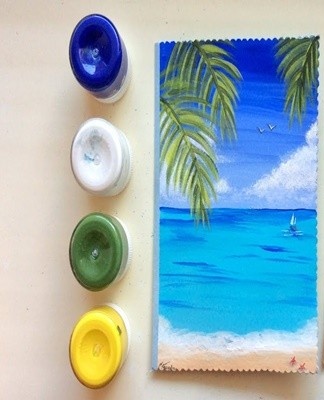
In the monotype technique, symmetrical color spots were made on the cards of the Rorschach associative psychological test.
diatypy
Technique also refers to the method of printing the image:
- apply a layer of paint with a roller on a smooth dense surface;
- put a sheet of thin paper on fresh paint;
- draw a picture with a pencil;
- remove a thin sheet.
The drawing will be printed on thick and thin paper, and you will get two images with the same plot. Lines can be applied with sticks of different thicknesses and multiple colors can be applied on a solid base. An image on a colored background looks three-dimensional and non-standard. Instead of a roller, use a cotton cloth. To better position the objects, replace the white sheet with translucent tracing paper.
Blotography
The technique consists of dabbing and projecting paint onto the canvas.
How is it made:
- dip the brush into the paint;
- wait for the drop to flow onto the paper or spray gouache randomly on the surface with your hand;
- blow on large convex drops from above or through a cocktail straw.
At first, abstract drawings from stains will be obtained. To give them the shape of animals and plants, they alternate large and small sprays. The painting is also coated with paper attached on top.
In the blotter technique, interesting marine life is obtained: anemones, corals, jellyfish, molluscs. With the help of spots it is easy to depict water, rain, a drop in slow motion.Splashes can be placed on a solid, dry background or secondary objects can be painted with ordinary strokes or using other techniques.
happy
In the technique, brushes are not used, but the paint is applied by hand. There are two types of events:
- apply color spots with palms and fists;
- draw and color objects with your fingertips.
The contact drawing method develops fine motor skills in children. For finger painting, a special gouache is produced on the basis of natural pigments and adhesives. They are gentle on the skin and easy to wash off.

Gouache painting techniques
The combination of water and paints, using a sponge allows you to achieve a smooth transition of shades and create bizarre shapes.
Wet on wet
The technique is used to depict vague shapes - clouds, fog.
How to do:
- moisten the sheet with clean water with a brush;
- apply a clear coat of paint of the same color;
- without waiting for drying, immediately apply a liquid coat of the second color on top.
The colors will blend on the canvas to create a blurry, blurry background. The following colors must be applied quickly and well diluted with water, otherwise they will not mix.
Wet on dry
Using the technique, objects with clear outlines are drawn:
- smears of thick paint are applied to a dry surface;
- with dark colors they combine contrasting light colors.
Painting with strokes is a classic way of working with gouache.
Disguise
For work you will need a masking liquid - a special tool that protects the paper from painting. It is sold at art supply stores.Masking is used to produce white shapes or letters with clear outlines.
How to do the technique:
- the paper is covered with masking liquid;
- when the surface dries, gouache is applied on top;
- remove the disguise from the dried paint with a coat of paint.

It is important to wait for the masking liquid to dry, otherwise it will stick to the paint and peel off with the paper. The dried disguise does not stick to the hands and looks like glue. Pull it out with a needle or your fingers to remove it.
Lighting
The technique makes it possible not to mix the paints, but to lighten them with a few shades with a damp cloth:
- draw the object with an even layer of gouache;
- moisten a cloth in water, wring it out;
- erase the drawing.
Brightening also removes color entirely, but unlike masking, the edges of a brightened object will be jagged. Leaves and flowers are painted on the bottom with a cloth and a template. A hole is cut in a sheet of paper to match the shape of the object and placed on the canvas. The fabric is dipped in paint and dabbed onto the canvas on the stencil.
Sponge
The porous material leaves an impression of volume. The sponge is dipped in the paint and the design is stamped. In this way, a rough or dense texture is depicted - the earth, a dense crown of trees, grass.
sgraffito
How to do:
- apply a background tone;
- garnish with darker or lighter strokes;
- scrape off the top layer to reveal the bottom.
The paint is cleaned with a needle, a sharpened stick, a knife. Reception is carried out quickly, until the top layer is dry. Gouache paintings, painted with the sgraffito technique, look like etchings.In this way, the texture is usually represented in the foreground, giving the effect of scratches.
Highlighting
The technique is used to draw ripples in water, veins on leaves, branches in treetops. A layer of gouache is applied to the canvas, grooves are made with sharp tools in the right places, and they are filled with a different color.
Splashes
Using an unusual technique, small volumetric objects are depicted - pebbles, leaves, drops.
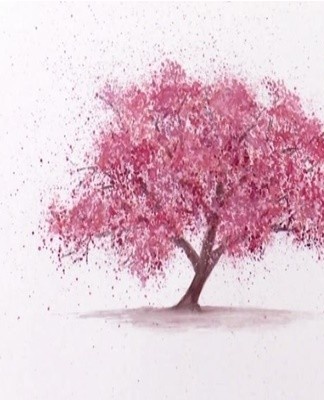
How to do:
- dip the brush into the paint;
- raise the pile;
- pull the hairs towards you, direct them towards the canvas and release them briskly.
The paint sprinkles the paper in small droplets and you get an unusual texture.
For spraying, use a brush with stiff bristles. Cover the rest of the paint with a piece of paper to drop the splatter in a specific spot.
Simple step-by-step paintings
The peculiarity of phased drawing is that the main objects and the background are drawn only with horizontal strokes. Then highlights, shadows and small details are added with light and dark tones.
A tree in the snow
Execution mode:
- Apply the background with the first layer - blue sky and white snow on the ground;
- wait for the paint to dry;
- draw in pencil in the center, on the right or on the left, a tree;
- circle the outline of the trunk and branches with brown, paint with black inside;
- the ends of the branches, highlight the bottom of the trunk in white;
- draw the shadow in the snow in gray.
Finally, add some expression to the sky with pink horizontal strokes at the horizon and dark purples at the top of the composition.
mountain landscape
How to draw:
- with a simple pencil draw the contours of the mountain peaks;
- draw the sky blue;
- depict clouds in white;
- mix blue and purple tones and paint over the mountains;
- highlight the slopes with white paint on which the sun falls;
- use the tip of a wide brush to outline the ledges on the slopes; the paint can also be applied with the edge of a palette knife;
- combine blue and white paint and highlight the foothills of the mountains;
- draw a coniferous forest bordering the hills with blue, green and yellow strokes;
- paint the earth with a mixture of green, yellow and light brown;
- again mix the colors white and blue, paint the lake in the foreground, add reflections of greenery of the banks and white reflections on the water;
- with touches of green and blue to represent the bushes on the shore.
In conclusion, draw a flower carpet with small white, ocher, emerald and light purple strokes.

Leaves
An easy way to draw the small foliage of a tree:
- outline the trunk and branches with a pencil;
- paint with brown color, draw small branches;
- Dip a flat brush into the green, hold it perpendicular, outline the pointed crown. The dabbing method replaces splashing.
Tulip
How to draw a flower:
- draw the stem, leaves and bud with a simple pencil;
- paint the petals red and the leaf green;
- make the stem darker;
- apply a second layer of color and represent a shadow;
- add black to the red shade and draw the edges of the petals, highlight the shadow;
- apply white glare to the light side;
- apply a light purple tint to the base of the bud.
On the petals you can depict drops: put dots in dark red and light purple and drip white on top.
Interesting ideas for beginners
As a child, it is interesting to draw everything. Like the little akyns of the fine arts, children draw what they see. Under the brush of young artists in bright colors appear the garden of grandmother, a teacher in their eyes, the pit bull of a neighbor and the father turning on a light bulb.
Perception becomes dull in adulthood. Among everyday things and affairs, it is difficult to find an image that will amaze the imagination, and you want to capture it in paintings.
The following ideas will help spark the artistic imagination:
- look at old photographs or children's drawings, remember what you liked to draw in childhood - people, animals, funny cartoons;
- search for pictures on the Internet on a chosen subject and try to reproduce using various drawing techniques;
- draw a simple or favorite thing from nature - an antique vase, a car, a book;
- turn to classic subjects - buy different fruits and draw a still life with a play of light and shadow, depict a houseplant or a bouquet.
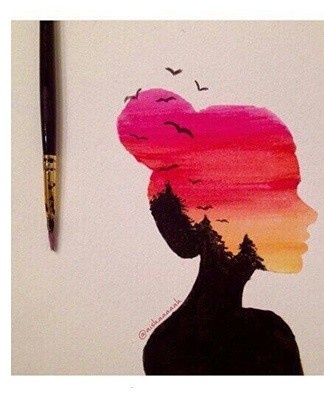
You can draw from nature or from a photo: pets, favorite movies and pop stars. Art lovers will be interested in reproductions of world masterpieces - paintings in the pop art style of Andy Warhol, a portrait of Marilyn Monroe, Mona Lisa, "The Scream" by Edvard Munch or "Starry Night" by Van Gogh. At the same time, it is not necessary to achieve exact similarities and copy the technique of the authors. The result is unexpected and even funny images.
Master class on complex drawing
An interesting effect is achieved by drawing on crumpled paper.The pigment fills in the fractures and the image looks like a marbled pattern. Using this technique, they paint a tropical landscape.
For the art you will need:
- gouache;
- watercolor paper;
- simple pencil;
- wide and thin brush;
- the iron.
Execution technique:
- crumple a sheet of paper tightly, then smooth it out and spread it with your hands;
- prepare a wide brush;
- draw a horizon line with diluted blue;
- in the center above the horizon, draw a semicircle of the sun with translucent yellow gouache;
- paint on the half sun;
- blend the color towards the center with a damp brush;
- draw the outline of the sun with a translucent orange color;
- blend outward with a damp brush;
- paint the sky around the edges of the sheet with pink or purple, the paint is still well diluted in the state of watercolor;
- blend again with a damp brush to the center of the sheet;
- under the semi-circle of the sun, put three lines in the shape of the corners of an inverted triangle and also blur it to obtain a reflection of the sun;
- on the sides under the horizon line, put strokes with blue paint and mix them with shadows with yellow ones;
- paint on the bottom of the sheet, which represents the ocean, with lines and blurring;
- wait until the paint is dry;
- ironing with an iron;
- Dip a thin brush in black gouache and draw two lines from the lower left corner - future palm trees;
- bold them and mark the trunks, and draw leaves on the tops;
- on the bottom of the water, draw the outlines of the dolphins in pencil and paint over it in black;
- along the edges of the picture, mark the contours of the tropical leaves, and also sketch in black.

The result is an ocean sunset looking through the jungle.
Secrets and intricacies of working with gouache
A set of gouache paints consists of four, six or sixteen colors. Large art sets are available in 32 shades. Adjacent tones in a color palette give a uniform color when mixed and contrasting tones with a gray tint. How to mix the paints together to obtain new shades, the following table shows:
| Shadow | Combination of paints |
| fishing | red+yellow+white |
| beige | yellow + white + light brown |
| turquoise | green + blue |
| mustard | red + yellow + green |
| olive | yellow + green |
| gold | red + yellow |
| citric | yellow + green + white |
| ocher | brown + yellow |
| mauve | blue + yellow + red |
| khaki | green + brown |
| Red Bordeaux | red+brown+yellow+black |
| crimson | blue+red+white+brown |
| plum | red+white+blue+black |
| my dear | yellow + brown + white |
| light green | yellow + green + white |
What else is useful to know about working with gouache paints:
- Before applying, grease the paper with clean water and allow to dry. The sheet will stretch and not curl into a tube after the paint dries;
- gouache is diluted with water to the consistency of liquid sour cream;
- so that the paint does not exfoliate, stir it thoroughly;
- the pigment in too liquid a layer lays down unevenly, individual spots are difficult to cover with the next layer;
- the horizontal lines overlap with the vertical lines;
- so that there are no dirty streaks, black is not used to superimpose the shadows of objects;
- the fabric is coated with a special gouache anti-rolling agent - wetting agent No. 1, containing bovine bile;
- before working on a poster for the street, gelatin is added to gouache;
- to eliminate unnecessary strokes, soften the dry paint on the canvas with a damp brush.In this case, the tone will lighten, the contours will be smeared;
- if the color is not well chosen, you can paint over it;
- paint applied on a dark base brightens after drying and darkens on a light background;
- to see how the color will look after drying, make a palette of control paints;
- in order for the diapers to dry faster, they can be dried with a hair dryer;
- add gum arabic to the cracked paint and mix;
- the paintings on a wooden base are varnished.
Gouache can be stored in tightly closed jars at room temperature. Finished paintings are not folded into tubes, because a thick layer of paint breaks and crumbles. The works are folded into a folder, putting tissue paper between the sheets. This will prevent the paint from being printed on the back of the paintings.

